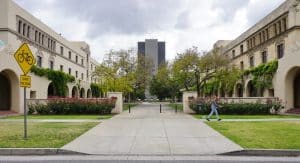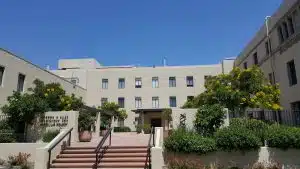What Is Caltech Known For?
What is Caltech known for? California Institute of Technology, or Caltech, is a leading science and engineering school. It gathers top minds and cutting-edge tools to address key scientific and societal issues. Caltech’s talented faculty and students explore the universe and create future technologies. Their research covers a wide range of areas, including quantum science, engineering, bioinformatics, life sciences, human behavior, economics, energy, and sustainability.
Caltech Fast Facts
- Location: Pasadena, CA
- Student Population: 1,023
- Acceptance Rate: 3.9%
What is Caltech known for?
The prestigious California Institute of Technology (Caltech) boasts many notable achievements. Among them, 58 faculty and alumni have received a National Medal of Science, and the university currently has seven Nobel laureates in residence. Additionally, Caltech manages the Jet Propulsion Laboratory (JPL), the foremost center for robotic exploration of the solar system.
What else is Caltech, a STEM-focused institution, known for?
- Toprank Academics
- World-renowned Science and Engineering University
- Strong Focus on Research, Innovation, and Technology
- Influential Roster of Alumni
- Exciting Campus Culture
Top Rank Academics
What is Caltech known for in the world of academia? The California Institute of Technology (Caltech) is famous worldwide for its excellence in science and engineering. Despite being small, it consistently ranks among the top universities due to its tough academic programs, groundbreaking research, influential faculty, and major contributions to science and technology.
Several key factors contribute to Caltech’s prestige. Its highly selective admissions process, with an acceptance rate of about 6-8%, ensures only the most capable students are admitted. Caltech has produced 46 Nobel laureates among its faculty and alumni, including notable figures like physicist Richard Feynman, chemist Linus Pauling, and astrophysicist Kip Thorne.
Caltech is also known for its groundbreaking research. The Jet Propulsion Laboratory (JPL), managed by Caltech for NASA, has been crucial in space exploration with achievements like the Mars rovers and the Voyager missions. Caltech’s curriculum focuses heavily on STEM fields, offering a challenging academic environment with a strong emphasis on fundamental research and innovation.
Caltech was founded as Throop University by Amos G. Throop in 1891 and was renamed the California Institute of Technology in 1920. In the 1930s, under the leadership of Nobel laureate Robert A. Millikan, Caltech gained significant prestige, transforming into a world-class research institution.
The 1960s saw the establishment of the Jet Propulsion Laboratory (JPL) under Caltech’s management, leading to major contributions to space exploration, including the successful landing of the Viking probes on Mars. In 2004, Caltech physicist Kip Thorne, along with Rainer Weiss and Barry Barish, contributed to the discovery of gravitational waves, earning the 2017 Nobel Prize in Physics.
Caltech encourages an interdisciplinary approach to education and research, fostering collaboration across various fields. With a student-to-faculty ratio of approximately 3:1, the institute provides a highly personalized and intensive educational experience. Undergraduate students are actively involved in research projects, often working alongside graduate students and faculty on cutting-edge research.
World-renowned Science and Engineering University
What is Caltech known for in the field of STEM? Caltech is renowned for its strong focus on science and engineering, consistently ranking among the top institutions in these fields. This emphasis has helped Caltech create some of the best science and engineering programs in the country through rigorous academics, innovative research, and influential faculty.
Key Programs and Departments
Division of Engineering and Applied Science (EAS)
- Programs: Offers undergraduate and graduate programs in various fields including Aerospace, Mechanical Engineering, Electrical Engineering, Environmental Science and Engineering, and Materials Science.
- Courses: Key courses include “Computational Fluid Dynamics,” “Control and Dynamical Systems,” “Quantum Mechanics,” and “Machine Learning.”
Division of Physics, Mathematics, and Astronomy (PMA)
- Programs: Provides programs in Physics, Mathematics, and Astronomy.
- Courses: Key courses include “Advanced Electromagnetism,” “Quantum Field Theory,” “Astrophysics,” and “General Relativity.”
Division of Chemistry and Chemical Engineering (CCE)
- Programs: Offers programs in Chemistry and Chemical Engineering.
- Courses: Key courses include “Organic Chemistry,” “Chemical Thermodynamics,” “Reaction Engineering,” and “Materials Chemistry.”
Caltech has six divisions:
- Biology and Biological Engineering (BBE)
- Chemistry and Chemical Engineering (CCE)
- Engineering and Applied Science (EAS)
- Geological and Planetary Sciences (GPS)
- Humanities and Social Sciences (HSS)
- and Physics, Mathematics, and Astronomy (PMA)
Although computer science is the most popular major, Caltech offers 28 other majors, such as bioengineering, astrophysics, geobiology, materials science, and mathematics. In addition to STEM fields, students can explore English, history, and political science programs, with HSS programs frequently integrating a scientific perspective. Additionally, students can minor in areas like aerospace, computer science, philosophy, and structural mechanics.
Students at Caltech can create personalized curricula through the Interdisciplinary Studies Program (ISP) in collaboration with faculty advisors. The university collaborates with other colleges to provide additional programs and opportunities, such as an exchange program with the University of Chicago during fall terms.
Caltech also offers a 3/2 program, allowing students from select liberal arts colleges to transfer to Caltech after their junior year. These students spend an additional two years at Caltech, earning a bachelor of science from Caltech and a bachelor’s degree from their home institution. Participating colleges include:
- Bowdoin College
- Bryn Mawr College
- Grinnell College
- Haverford College
- Mt. Holyoke College
- Oberlin College
- Occidental College
- Ohio Wesleyan University
- Pomona College
- Reed College
- Spelman College
- Wesleyan University
- Whitman College
Caltech provides a study abroad program for junior or senior students, who may apply to study at the following institutions:
- University of Edinburgh in Edinburgh, Scotland
- Danish Technical University (DTU) in Copenhagen, Denmark
- École Polytechnique (EPT) in Palaiseau, France
- University of Melbourne in Melbourne, Australia
- University College London (UCL) in London, England
- University of Cambridge in Cambridge, England
- University of Copenhagen (UCPH)
Strong Focus on Research, Innovation, and Technology
This is one of the top answers to the question, ‘What is Caltech known for?’ Caltech, the California Institute of Technology, is famous for its strong focus on research, innovation, and technology. This focus shines through its academic programs, faculty, and the achievements of its students and alumni. Caltech receives significant funding from sources like NASA, the NSF, private foundations, and industry partners, supporting cutting-edge research across multiple disciplines.
The Office of Technology Transfer and Corporate Partnerships (OTTCP) helps bring Caltech-developed technologies to the marketplace, supporting startups and industry partnerships. The Caltech Entrepreneurs Forum offers resources, networking, and support for students and alumni interested in entrepreneurship, promoting a culture of innovation.
Projects like the Laser Interferometer Gravitational-Wave Observatory (LIGO), which detected gravitational waves, show Caltech’s commitment to groundbreaking discoveries. Advanced materials, robotics, and AI research further highlight Caltech’s innovative environment.
Caltech consistently ranks among the top institutions for STEM education and research. Its rigorous programs attract top-tier students and faculty. The institute offers advanced courses in areas like quantum mechanics, space engineering, and computational science, ensuring students are at the forefront of technological advancements. Interdisciplinary programs encourage collaboration between fields, promoting a holistic approach to solving complex problems.
Caltech’s faculty includes numerous Nobel laureates, Turing Award winners, and members of prestigious academies, whose contributions to science and technology are globally recognized. Its alumni have founded influential tech companies, contributed to significant advancements, and held leadership positions in major corporations and research institutions.
Research Centers and Facilities
- Jet Propulsion Laboratory (JPL): Managed by Caltech for NASA, JPL is a leading center for robotic exploration of the solar system.
- Beckman Institute: A multidisciplinary research facility dedicated to developing new methods, instruments, and materials for fundamental research in the chemical and biological sciences.
- Kavli Nanoscience Institute (KNI): Focuses on nanoscale research, fostering innovation in areas such as nanotechnology and quantum science.
- Resnick Sustainability Institute: Concentrates on sustainable energy and environmental solutions, fostering interdisciplinary research for sustainability.
As of 2024, Caltech affiliates have earned 45 Nobel Prizes, showcasing the institute’s impactful research. In 2015, the Laser Interferometer Gravitational-Wave Observatory (LIGO) achieved the first direct detection of gravitational waves—a major milestone in physics and astronomy. Caltech researchers have also made significant strides in synthetic biology, pioneering techniques for DNA synthesis and gene editing.
The Summer Undergraduate Research Fellowships (SURF) program offers undergraduates hands-on research experience with faculty on innovative projects. The Resnick Institute for Sustainability focuses on creating new technologies for sustainable energy and environmental solutions. Caltech’s dedication to research and innovation has made it a leader in scientific discovery and technological advancement, contributing significantly to various fields and driving global progress.
Influential Roster of Alumni
What is Caltech known for? Their impressive line up of famous and influential alumni. Caltech has produced numerous influential alumni who have significantly contributed to their respective fields. Here are some of the most notable ones:
Gordon Moore
- Field: Semiconductor Industry
- Contributions: Co-founder of Intel Corporation and author of Moore’s Law, which predicted the exponential growth of computing power.
Charles Townes
- Field: Physics
- Contributions: Nobel Prize in Physics in 1964 for his work on quantum electronics and the development of the maser and laser.
Carver Mead
- Field: Electrical Engineering and Computer Science
- Contributions: Pioneering work in VLSI (very-large-scale integration) design and author of seminal texts in computer science.
Frank Borman
- Field: Space Exploration
- Contributions: NASA astronaut, Commander of Apollo 8, the first mission to orbit the moon.
Harrison Schmitt
- Field: Geology and Space Exploration
- Contributions: NASA astronaut and geologist, Apollo 17 moonwalker, and U.S. Senator from New Mexico.
Linus Pauling
- Field: Chemistry and Peace Activism
- Contributions: One of only two people to receive two unshared Nobel Prizes: the Nobel Prize in Chemistry (1954) for his research on the nature of the chemical bond, and the Nobel Peace Prize (1962) for his activism against nuclear weapons.
Arden L. Bement Jr.
- Field: Engineering and Public Service
- Contributions: Former Director of the National Science Foundation (NSF) and key figure in the development of nuclear materials and reactor safety.
Frances Arnold
- Field: Chemical Engineering
- Contributions: Nobel Prize in Chemistry in 2018 for her work on the directed evolution of enzymes, which has applications in biofuels, pharmaceuticals, and other areas.
Robert Grubbs
- Field: Chemistry
- Contributions: Nobel Prize in Chemistry in 2005 for his development of the metathesis method in organic synthesis, which is widely used in the chemical industry.
Ahmed Zewail
- Field: Chemistry
- Contributions: Nobel Prize in Chemistry in 1999 for his pioneering work on femtochemistry, the study of chemical reactions on extremely short timescales.
Bill Gross
- Field: Finance and Investment
- Contributions: Co-founder of PIMCO, one of the world’s largest fixed-income investment firms, and a leading figure in the bond market.
Gene Roddenberry
- Field: Entertainment and Media
- Contributions: Creator of the iconic science fiction television series “Star Trek,” which has had a profound impact on popular culture and inspired generations of scientists and engineers.
David Ho
- Field: Medicine
- Contributions: Pioneering AIDS researcher and Time magazine’s Man of the Year in 1996 for his groundbreaking work on the treatment of HIV.
Sally Ride
- Field: Space Exploration and Education
- Contributions: First American woman in space, advocate for STEM education, and founder of Sally Ride Science, an organization promoting science education.
Kip Thorne
- Field: Theoretical Physics
- Contributions: Nobel Prize in Physics in 2017 for his contributions to the LIGO project and the detection of gravitational waves, as well as his work in astrophysics and relativity.
Robert Millikan
- Field: Physics
- Contributions: Nobel Prize in Physics in 1923 for his work on the elementary charge of electricity and the photoelectric effect.
Caltech alumni have significantly impacted various fields, including science, technology, finance, entertainment, and public service. Their contributions have shaped industries, advanced knowledge, and inspired future generations.
Exciting Campus Culture
What is Caltech known for? Is it known for its campus? The answer is a resounding YES! Caltech’s campus culture is unique, with a strong sense of community, intellectual curiosity, and a balance between academics and fun traditions. The house system features eight undergraduate houses, each with its own culture and traditions.
These houses organize social events, study sessions, and intramural sports, creating close-knit communities and support systems. One beloved tradition is Ditch Day, where seniors create puzzles and pranks for underclassmen, leading to a day of themed challenges and campus-wide participation.
Interhouse parties, each with creative themes, showcase students’ ingenuity and teamwork. Notable pranks include changing the Hollywood sign to “Caltech” and placing a car on a building. Rotation helps new students get to know each house before choosing where to live, ensuring they find a community that fits their personality and interests.
What is Caltech known for in terms of campus activities? Caltech is known for and offers numerous student clubs and organizations, from academic and professional groups to recreational and cultural clubs like the Caltech Robotics Team and the Caltech Y. Academic competitions such as the Putnam Mathematical Competition and the International Collegiate Programming Contest foster intellectual challenge and achievement. Despite its small size and STEM focus, Caltech has a vibrant performing arts scene with theater, music, and improv opportunities.
What is Caltech known for in terms of campus activities? The Caltech Y organizes community service projects, outdoor adventures, and social justice programs, encouraging students to engage with the broader community. Resources for physical and mental well-being, including the Counseling Center, health services, and wellness programs, support students’ holistic health with activities like yoga, meditation, and stress-relief workshops.
Festivals and celebrations such as the annual Spring Carnival, International Day, and cultural festivals unite the entire community. Collaborative projects encourage teamwork, creativity, and real-world application of classroom knowledge. The Career Development Center offers resources like career fairs, networking events, and workshops and connects students with industry leaders, alumni, and potential employers.
Caltech’s international and cultural exchange programs, study abroad opportunities, and cultural events broaden students’ perspectives and global experiences. State-of-the-art labs, maker spaces, and collaborative workspaces emphasize hands-on learning, problem-solving, and interdisciplinary collaboration. Overall, Caltech’s campus culture blends intellectual rigor, creativity, community engagement, and a spirit of innovation, creating an enriching academic and personal growth environment.
Frequently Asked Questions
Is Caltech an Ivy League school?
No, Caltech (California Institute of Technology) is not an Ivy League school. The Ivy League consists of eight private colleges and universities in the northeastern United States, known for their history, academic excellence, and social prestige. Caltech is renowned for its strong emphasis on science and engineering and is consistently ranked among the top universities in the world. However, it is not part of the Ivy League.
What majors is Caltech known for?
What is Caltech known for academically? Caltech is famous for its challenging and prestigious programs, especially in science and engineering. Here are the top 5 majors Caltech is known for:
- Physics: Caltech’s Physics program is highly respected, known for significant research and numerous Nobel laureates. It covers a wide range of topics, from theoretical to experimental physics.
- Computer Science: This program is recognized for cutting-edge research and a strong focus on both theoretical and practical computing. It excels in areas like algorithms, artificial intelligence, and machine learning.
- Electrical Engineering: Known for contributions to both fundamental and applied research in telecommunications, signal processing, and electronics.
- Chemical Engineering: Highly regarded for its research and innovation in chemical processes, materials science, and biochemistry.
- Mechanical Engineering: Emphasizes research in robotics, fluid mechanics, and aerospace engineering.
These programs contribute to Caltech’s reputation as a top science and engineering education and research institution.
What sport is Caltech known for?
What is Caltech known for in terms of athletics? Caltech prioritizes academics and research, with athletics taking a back seat. However, Caltech is best known for its basketball team. The men’s basketball team gained fame for ending a 26-year losing streak with a victory in 2011, breaking a 310-game conference losing streak. This win symbolized perseverance and the spirit of collegiate athletics.
Besides basketball, Caltech offers sports like swimming, water polo, tennis, and track and field. While athletics are less emphasized, these programs give students opportunities for physical activity and team building. Caltech aims to create a balanced environment where students can excel academically while enjoying competitive and recreational sports.
What are the odds of getting into Caltech?
The odds of getting into Caltech are quite low due to its highly selective admissions process. For the class of 2027, Caltech received approximately 13,026 applications and admitted only 412 students, resulting in an acceptance rate of about 3.2%. This acceptance rate places Caltech among the most selective universities in the world.
To provide more context, the admitted students typically have exceptional academic credentials. The middle 50% range for SAT scores is around 1530-1570, and for ACT scores, it is around 35-36. Additionally, admitted students often have a strong background in mathematics and science, including advanced coursework and significant achievements in these areas. Caltech also places a strong emphasis on research experience, creativity, and problem-solving skills in its admissions process.










































